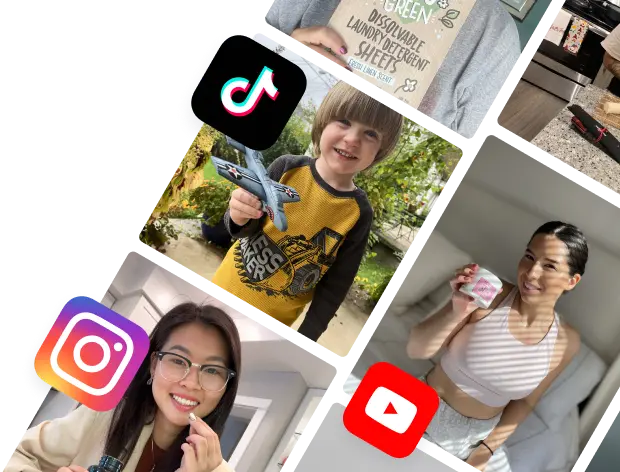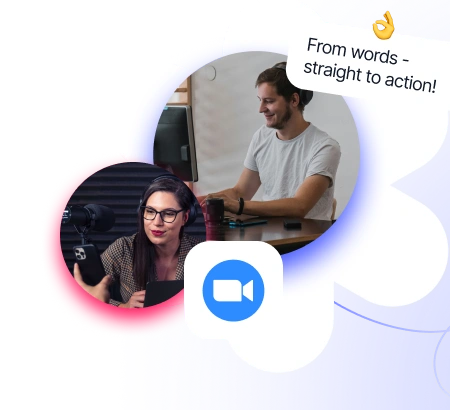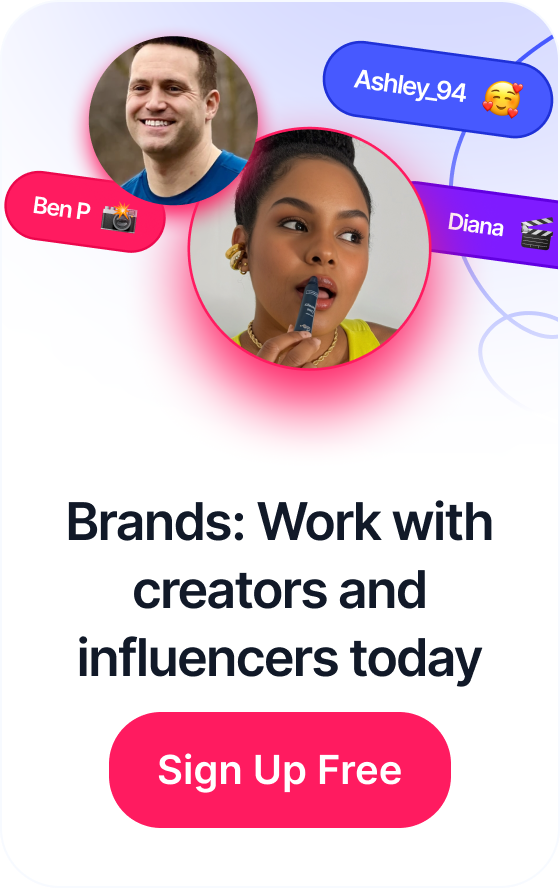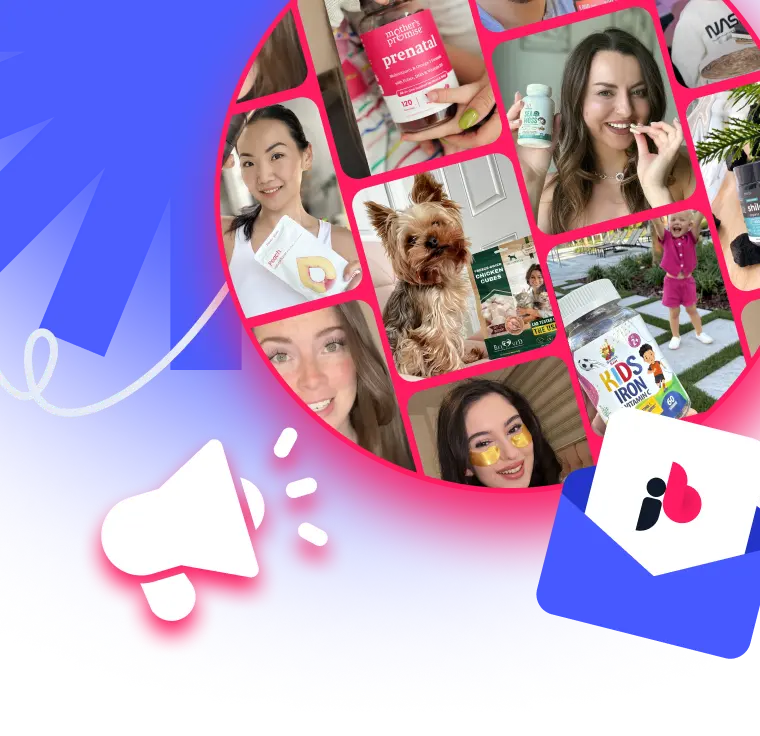 Top 16 Micro-Influencer Platforms for Enhancing Your Brand Visibility in 2025
Top 16 Micro-Influencer Platforms for Enhancing Your Brand Visibility in 2025
Finding great user-generated content (UGC) creators is less about finding polished influencers and more about discovering authentic, relatable voices. The goal isn't to replicate a slick ad; it's to find everyday people who can create genuine content that truly connects with your target audience. It’s a strategy that’s proving far more effective than traditional advertising.
Table of Contents
From Polished Ads to Authentic Voices
The marketing playbook has fundamentally changed. High-production, glossy advertisements are being overshadowed by the raw, trustworthy content that UGC creators are so good at making. This isn't just some passing trend; it’s a deep shift in how people connect with brands.
Consumers are tired of being sold to. They're looking for real recommendations from people they see as peers.
The data backs this up completely. A staggering 93% of marketers report that content from real users outperforms their own branded content. That statistic reveals a critical insight: modern consumers are desperate for a human touch. They want to see how a product fits into a real person's life, not just how it looks in a sterile photo studio.
If you want to dig deeper, you can discover more statistics on the impact of UGC, but the takeaway is clear—this is no longer optional.
Why Real People Matter More Than Ever
The biggest challenge for any brand today is simply cutting through the noise. An authentic voice, delivered by a UGC creator, does this in a few powerful ways:
- It Builds Instant Credibility: When a real customer shows off your product, it’s a powerful form of social proof. It tells potential buyers, "Hey, people like me actually use and love this."
- It Drives Relatability: A UGC creator can show your product in a real-world setting—a skincare routine in a normal bathroom, not a Hollywood set, or a new gadget being used on a messy desk. This helps your audience immediately picture themselves using it.
- It Fosters a Community: When you feature content from your audience, you turn customers from passive buyers into active participants in your brand’s story. They become part of the narrative.
The magic of UGC is that it isn’t an ad; it's a story. When you learn how to find UGC creators, you're not just sourcing content—you're recruiting storytellers who can connect with your audience on a human level.
Ultimately, you need to find creators who align with your brand's soul. In a sea of millions of potential partners, this guide gives you a practical framework to find the ones who will genuinely amplify your message and build lasting connections.
Here's a quick overview of the main methods we'll be diving into.
Core Methods for Finding UGC Creators at a Glance
This table gives you a quick summary of the primary strategies for discovering UGC creators. Use this to quickly identify the best approach for your brand's needs and resources.
| Method | Best For | Key Consideration |
|---|---|---|
| UGC Platforms | Brands needing speed, scale, and a streamlined workflow. Perfect for getting lots of content fast without manual outreach. | Platform fees are a factor, but they often save significant time and administrative overhead. |
| Manual Outreach | Brands looking for very specific, niche creators or those wanting to build deep, long-term relationships from scratch. | Highly time-consuming. Requires strong negotiation skills and a system for managing contracts and payments. |
| Existing Customers | Brands with an established, loyal customer base. The most authentic source of UGC. | You need to have an engaged community first. Incentives (discounts, free products) are key to encouraging participation. |
| Hashtag Research | Discovering creators who are already organically talking about your industry, competitors, or brand. | Requires diligent searching on platforms like TikTok and Instagram. Content rights must be negotiated after discovery. |
Each of these methods has its place, and the best strategy often involves a mix of two or more. Now, let's break down exactly how to execute each one.
Defining Your Ideal Creator Profile Before You Search
Hold on. Before you dive headfirst into scrolling through hashtags or browsing creator marketplaces, you need to pump the brakes. This is the single most important step, and skipping it is like going grocery shopping without a list—you'll wander aimlessly, waste a ton of time, and come home with a bunch of stuff you don't actually need.
Let's get strategic. We need to build an Ideal Creator Profile (ICP). Think of it as a documented brief that becomes your North Star for this whole process. It keeps you honest and ensures every creator you even think about is measured against the same standards. This is how you make objective decisions that actually push your campaign goals forward.
Aligning Goals with Creator Tiers
First things first: what are you actually trying to achieve here? Is the main goal to get your brand name out there and boost awareness? Are you looking to drive direct sales for a hot new product? Or maybe you just need to stock up on high-quality, authentic content for your ads and social feeds.
Your answer directly shapes the type of creator you need.
If you’re building a content library, you'll want to find creators known for their incredible video quality and aesthetic. But if it's all about sales, you need someone who is a master at crafting a compelling call-to-action that gets people to click "buy now."
Now, let's match those goals to the right creator tier:
- Nano-Creators (1k-10k followers): These are your grassroots champions. They have hyper-engaged, tight-knit communities that trust them immensely. They're perfect for generating incredibly authentic content that feels like a recommendation from a good friend.
- Micro-Creators (10k-100k followers): This is the sweet spot for many brands. Micro-creators give you a fantastic mix of solid reach and genuine authenticity. They have real credibility in their niche but don't come with the celebrity price tag.
- Macro-Creators (100k+ followers): If your goal is pure, massive reach, this is where you look. Macro-creators can get your brand in front of a huge audience, but be prepared for higher costs and potentially lower engagement rates compared to the smaller guys.
This isn't just theory; there's a real business impact when you align your goals with the right creators.
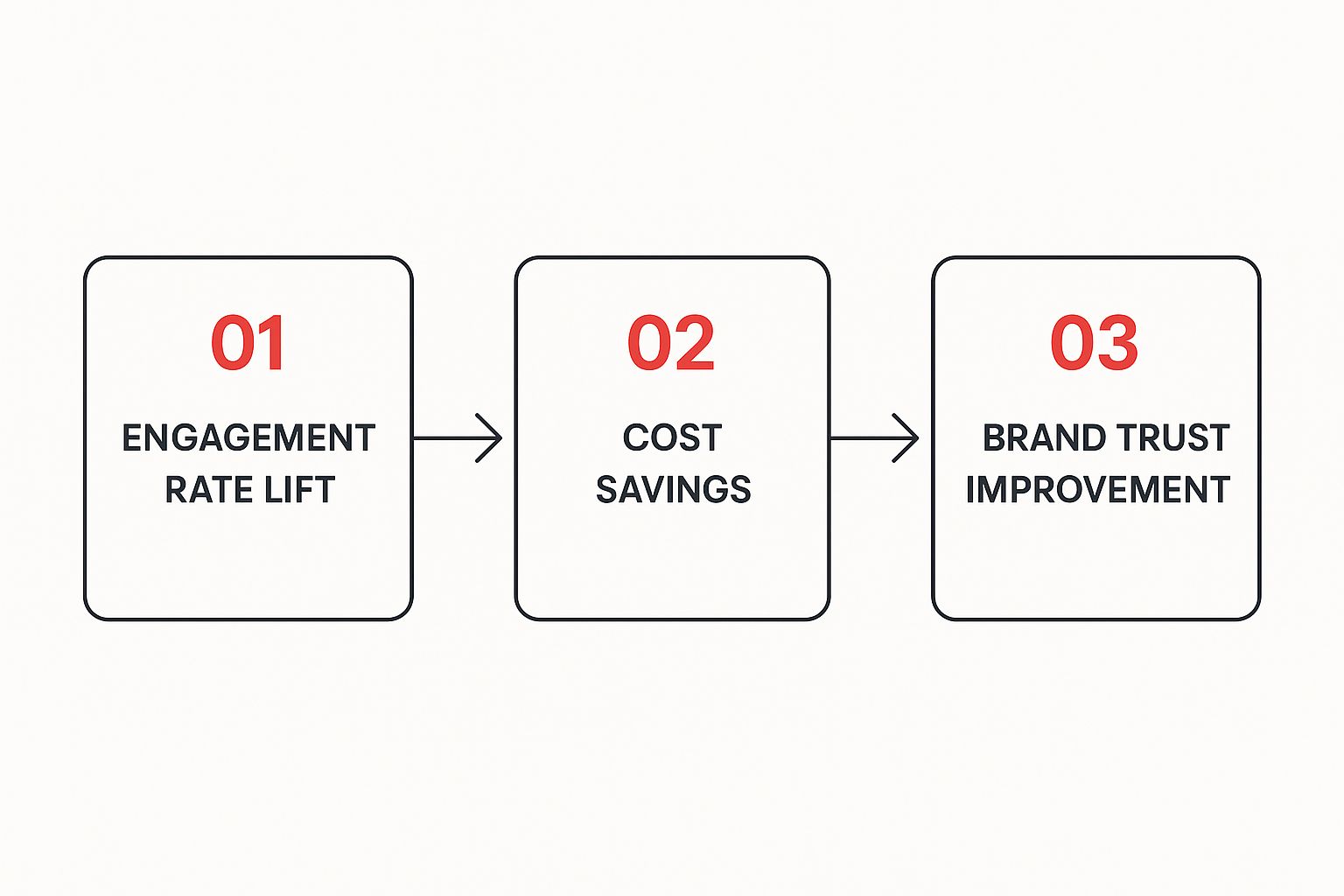
As you can see, a smart creator strategy doesn't just look good on paper—it leads to better engagement, cost savings, and stronger brand trust. It delivers real, tangible results.
Establishing Your Brand Alignment Criteria
Follower counts and engagement rates are only part of the story. Your ICP absolutely must include criteria for brand alignment. This is all about protecting your brand’s reputation and making sure the content created feels like a natural extension of who you are.
Your ideal creator doesn't just use your product; they embody the values and aesthetic of your brand. Think of them as a seamless extension of your marketing team, speaking the same language as your target customer.
To nail this down, you have to ask yourself some tough questions. Get honest with the answers:
- Values: Does their personal brand and the content they've shared in the past line up with your company's core values? Are there any red flags?
- Aesthetics: Look at their visual style. Does their lighting, editing, and overall vibe fit with your brand’s look and feel? Or does it clash completely?
- Tone of Voice: How do they communicate? Are they funny, super educational, or more inspirational? Does it match the way you talk to your own audience?
By getting this all down on paper, you create an instant filter. It immediately weeds out creators who are a bad fit, saving you from countless hours of pointless vetting and awkward outreach emails. Your finished Ideal Creator Profile is an actionable tool that makes finding the perfect UGC creators faster and way more effective.
Mastering Manual Discovery on Social Platforms

While platforms and specialized tools are great for speed, sometimes nothing beats the precision of old-fashioned manual discovery. When you're looking for that perfect creator, you've got to be willing to roll up your sleeves and dive in yourself.
This hands-on approach is how you find the real hidden gems—creators who are already genuinely passionate about your niche. It’s where authenticity lives.
Your search should always start where your audience hangs out. For a visual product, that's Instagram. If you're chasing trends and raw, unfiltered video, TikTok is king. And for deeper dives like tutorials and reviews, YouTube still holds the crown. The trick is to put yourself in your customer's shoes. Where would they look for real-world examples?
And don't just stick to your own brand's hashtag. That's a great spot to find existing fans, but to find fresh voices, you need to cast a much wider net.
Uncovering Creators with Strategic Hashtags
Think of hashtags as social media's original search engine. But you have to be smart about how you use them. Throwing a generic tag like #ugc into the search bar will just open the floodgates to a ton of irrelevant noise. The real magic happens when you start layering your searches.
Try combining broader industry terms with tags that creators use to signal they're open for business. For instance, instead of just searching #skincare, you could look for combinations like:
#ugccommunity+#cleanbeauty: This helps you find creators who are actively looking for partnerships specifically in the clean beauty space.#ugcforbrands+#techgadgets: A perfect combo to locate creators who specialize in making content for tech companies.#ugccreator+#[yourcity]: Use this to find local talent, which is amazing for events or geo-targeted campaigns.
This layering technique instantly whittles down millions of posts into a manageable list of people who are practically raising their hands to collaborate.
Analyzing Your Competitors' Mentions
Here's a pro tip: your competitors are already doing some of the legwork for you. One of the absolute best ways to find talented UGC creators is to see who's tagging your direct and indirect competitors. Just head over to their Instagram or TikTok profiles and check out their "tagged posts" section.
It’s a goldmine. You'll find a mix of organic fans and creators who were paid for a collaboration. Both are incredibly valuable leads for your brand.
Look beyond the big names with huge followings. Some of the most compelling and authentic content comes from nano-creators. They might have a smaller audience, but their excitement for a product is often more genuine and can have a massive impact.
As you're browsing, train your eye to look for quality, not just follower count. Is the lighting decent? Is the audio clear? Do they have a unique way of telling a story? This quick quality check will save you a ton of time down the road.
Organizing Your Manual Search Findings
A manual search can get messy—fast. Without a solid system, you’ll quickly lose track of promising profiles, forget who you've looked at, and end up duplicating your work. This is where a simple spreadsheet becomes your best friend.
Seriously, just open up Google Sheets or Excel and create a tracker. Here are the columns I recommend to keep everything straight:
- Creator Name: Their handle or real name.
- Platform: Instagram, TikTok, etc.
- Link to Profile: A direct URL so you can get back to their page easily.
- Follower Count: Just a quick number for audience size context.
- Engagement Notes: A spot for your gut check. Do the comments look real? Are they actually talking to their community?
- Content Quality: Your personal rating (I use a simple A, B, C system) on their video and photo skills.
- Contact Status: A basic tracker like: Not Contacted, Reached Out, or Replied.
This simple document transforms a chaotic, browser-tab-fueled search into a structured process. It builds you a powerful, organized shortlist that's ready for the next phase: vetting and outreach.
Using Platforms And Tools To Scale Your Search
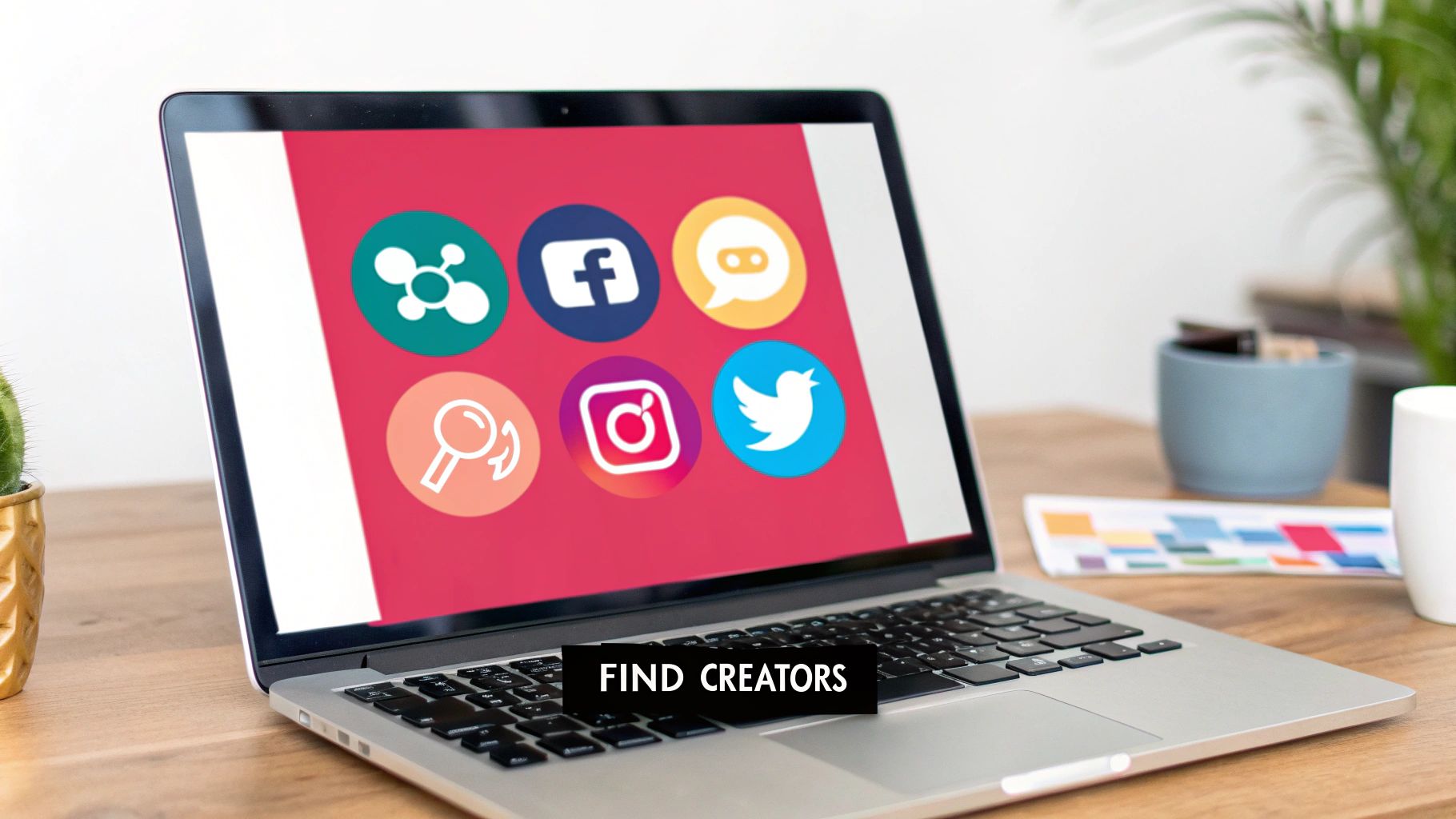
Manually digging through social media can uncover some real gems—those perfect, diamond-in-the-rough creators. But let’s be honest, it's a massive time suck. If you need to find talent at the speed your marketing calendar demands, you have to bring technology into the mix. This is where dedicated platforms and tools become your best friend, turning a search that could take days into a task you can knock out in a few hours.
The need for this kind of efficiency is staring us right in the face. A staggering 41% of marketers point to content creation management as a major headache. The bottleneck is often just finding good talent; in fact, 43% of marketers say it's incredibly difficult to discover high-quality user-generated content without some form of automation.
And with 86% of companies now using UGC, the right tools aren't a luxury anymore. They're a necessity to keep up. You can read more about these content creation challenges to see just how critical good tools have become.
Choosing Your UGC Discovery Engine
Not all platforms are built the same. They generally fall into two buckets, and each serves a slightly different role in your hunt for the best UGC creators.
- Dedicated UGC Marketplaces: Think of platforms like Billo, Insense, and our own JoinBrands. These are built specifically for this purpose. They’re transactional hubs where you post a brief, and creators apply to make content for you. They are absolutely perfect for quickly sourcing a high volume of content for ad campaigns or your social feed.
- Influencer Marketing Platforms: Then you have tools like Upfluence or Grin. These are broader discovery engines that let you search huge databases of creators with advanced filters. They're often geared more toward long-term, relationship-based influencer campaigns rather than purely transactional content creation.
For most brands whose main goal is getting authentic visual assets, a dedicated UGC marketplace is the most direct route. You get the content you need without the overhead of managing long-term relationships.
Mastering Platform Filters For Precision
The real magic of these platforms is in their filtering capabilities. Instead of mindlessly scrolling, you can build a hyper-targeted list of qualified candidates in minutes. It's like taking that Ideal Creator Profile we talked about earlier and using it to program your search.
Your goal on these platforms isn't just to find creators; it's to find the right creators efficiently. Smart filtering is the key. It eliminates 90% of the noise, letting you focus only on candidates who meet your non-negotiable criteria.
To get the best results, you need to learn how to layer filters strategically. I always recommend starting broad and then slowly narrowing your focus.
- Audience Demographics: First, filter for creators whose audience actually matches your target customer. Use the age, location, and gender filters to make sure their community is the one you're trying to reach.
- Performance Metrics: Next, bring in the performance data. Set minimums for engagement rates to weed out creators with sleepy, passive audiences. Look for other metrics too, like average video views or likes per post.
- Content and Niche: Finally, use keyword searches to pinpoint creators who are already talking about things relevant to your brand. Search for terms like "cruelty-free skincare" or "home coffee setup." Look for specific tags or categories that align with your industry.
For example, a sustainable fashion brand might start a search for creators whose audience is 80% female, aged 25-40, located in the USA, with an engagement rate over 3%. Then, they'd add keywords like #slowfashion or #ethicalstyle. This is the kind of precision that’s flat-out impossible with manual searching, and it's how you truly scale your efforts to find UGC creators who will move the needle.
The Art of Creator Outreach That Gets a Response
So you've found the perfect creator. Their vibe matches your brand, their audience is engaged, and their content is top-notch. Great! But that's only half the battle. Now comes the moment of truth: reaching out.
Let's be real: a generic, copy-paste message is the fastest way to get your DM or email sent straight to the trash. If you want a response, your outreach needs to be as thoughtful as the content you're hoping to get.
The trick is to prove you've actually done your homework. Your first message should immediately show that you see them as a creative partner, not just another name on a spreadsheet. Mention a specific video or post of theirs you genuinely enjoyed. What about it stood out? This simple act of personalization is what cuts through all the noise.
Crafting the Perfect First Message
Creators are busy. They get dozens, if not hundreds, of pitches. You need to be concise but also give them enough information to be interested. Respect their craft and their time, and you're already ahead of the game.
To get that positive response, here's what your message should cover:
- A Personalized Hook: Always start with their name and reference a specific piece of their content. Something like, "Hey [Creator Name], I absolutely loved your recent video on [topic]. The way you explained it was brilliant!"
- Who You Are: Briefly introduce yourself and your brand. Don't just assume they know who you are.
- The "Why You": This is crucial. Explain why you think they, specifically, are a great fit for your brand. Connect their content style, their audience's interests, or their unique voice to your product.
- The Big Idea: Give them a high-level glimpse of the campaign. Are you thinking about a few TikToks, some Instagram Reels, or maybe a set of static photos? Keep it brief.
- A Simple Call to Action: End with a low-pressure question. "Would you be open to hearing more?" is all it takes. This opens the door for a deeper conversation about rates and deliverables without being pushy.
This approach shows genuine interest and respect for their time, which dramatically increases your chances of starting a real conversation.
Navigating Compensation and Agreements
Once a creator says they're interested, be ready to talk about money. A lot of brands get weird about this part, but being transparent is the best way to build a professional relationship.
Right away, ask for their rate card or media kit. This simple step shows you respect them as a business owner and sets a professional tone for everything that follows.
The creator economy is absolutely booming. In fact, over 165 million new creators have joined social media platforms since 2020. But remember, many of these creators aren't full-time professionals, so being clear and offering fair pay is how you build lasting trust. You can learn more about the astounding growth of the creator economy.
Be prepared to negotiate, but always aim for fairness. A key part of the negotiation is usage rights—where will you use the content, and for how long? This is a huge factor that directly impacts the price.
Finally, get it all in writing with a simple agreement. This doesn't need to be a 30-page legal document written in Latin. A straightforward contract just needs to cover the basics to protect both you and the creator:
- Deliverables: What exactly are they creating? (e.g., one 60-second TikTok video, two static Instagram posts).
- Timeline: When are the drafts and final versions due?
- Compensation: What's the final rate and when will they be paid?
- Usage Rights: Where can you use the content (paid ads, organic social, website) and for how long?
Putting this in place turns a one-off transaction into the foundation for a strong, long-term partnership.
Common Questions About Finding UGC Creators

As you start diving into the world of UGC, you’ll quickly find a few questions that pop up again and again. Getting these sorted out early on is the key to building a solid creator program without the headaches. Let's clear up some of the most common uncertainties we see brands wrestling with.
How Much Does a UGC Creator Typically Cost?
This is usually the first thing everyone asks, and the honest answer is: it really depends. There’s no standard rate card for UGC. The final cost comes down to a few things, like the scope of the project, how experienced the creator is, and—this is a big one—what you plan to do with the content.
Most payment structures fall into one of these buckets:
- Product Gifting: This is a common starting point, especially for nano-creators or those just building their portfolio. You send them free products, and they send you content back. It's a great way to test the waters and build relationships, but don't expect experienced creators to work for free products alone.
- Per-Video/Photo Fee: This is the most straightforward and popular model. A creator charges a flat fee for a specific deliverable, like a 30-second TikTok video or a package of five high-res images. You might see rates from $150 for a newer creator to $500+ for someone with a proven track record.
- Retainer: If you know you'll need a steady stream of content, a monthly retainer is a smart move. You pay a set fee, and in return, you get a guaranteed number of assets each month. This gives your content calendar some predictability and offers the creator stable income.
The real game-changer on cost is usage rights. A video you're only using for organic posts on your own social channels will cost way less than that same video licensed for paid ads. You have to be crystal clear about where and for how long you’ll use the content, as that directly shapes the price tag.
How Do I Know if a Creator Is Truly Authentic?
In an era of bots and vanity metrics, learning to spot genuine authenticity is a non-negotiable skill. A massive follower count can be totally meaningless if there's no real, engaged community behind it. Time to put on your detective hat.
First, just scroll through their past content. Does their style feel consistent? Do they seem to genuinely care about the stuff they post, or does it feel like they're just chasing trends?
Next, take a deep dive into their comment section. Are the comments just a bunch of generic "Great post!" replies, or are people asking specific questions and having real conversations? Authentic engagement is a two-way street. You want to see the creator actually talking with their audience. Be skeptical of accounts with thousands of followers but only a few bland comments on each post. A quick scan of their follower list for obviously fake, bot-like profiles can also tell you a lot.
Lastly, always ask to see a portfolio or media kit. This is a sign of professionalism. It lets you see their proudest work, check out their past brand collaborations, and get a feel for their experience level before you commit.
What Is the Difference Between a UGC Creator and an Influencer?
Getting this distinction right is crucial because it dictates your entire campaign goal. The lines can get a little blurry sometimes, but the easiest way to think about it is assets versus audience.
The primary value of an influencer is their audience. You're paying them to promote your product to their followers on their channels. The main goal here is tapping into their reach and credibility to drive awareness or sales.
The primary value of a UGC creator is the content itself—the asset. You’re paying them to create authentic, relatable content that your brand can use on its own channels. You own the content (as per your agreement) and can run it in ads, post it on your website, or use it on your social feeds. Their personal follower count is way less important than their ability to create great content.
Understanding this difference is everything. If you need a bank of high-quality videos for your ad campaigns, a UGC creator is what you're looking for. If you need to break into a new community and build trust, an influencer is the better bet.
Ready to stop searching and start creating? JoinBrands is the all-in-one platform that connects you with over 250,000 vetted creators ready to produce high-quality, authentic content for your brand. Find the perfect match, manage campaigns, and get the assets you need to grow—all in one place. Start your campaign today on JoinBrands.

